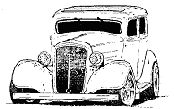Rotunda
Ford’s Car Show In The Round
By Calvin Mauldin
Photography: Ford Photomedia, The Ed Cortopassi Collection
In the latter part of 1954, Ford Motor Company's special events manager J.G. Mullaly hit upon a better idea with a brilliant stroke of inspiration. Why not capitalize on Ford's new colorful image by hosting a hot rod and custom car show under the roof of Ford's fabulous Rotunda in Dearborn? The youth of America still considered Ford products the mainstay for executing better ideas in performance and styling, since Chevy's high-revving 265 was just being introduced.
Ingenuity had been the cornerstone of Ford Motor Company's creation in the first place, with Henry building his first car in a backyard workshop and becoming the first American hot rodder of record.
Mullaly's plan was excellent in concept, yet he had enough wisdom in his tank to delegate the selection of the entries to the experts in altered automobiles--the members of the Michigan Hot Rod Association. While the MHRA picked the cream of the northern states' rods and customs, Ford's PR troops fired up the publicity machine, making those interested (or not) in cars aware of the show, scheduled for March 15-27, 1955. It's noteworthy that the Rotunda would be the hors d'oeuvre for the Third Annual Detroit Autorama at the National Guard Armory that April.
When the Rotunda's glass doors were opened to the denizens of Motown on March 15, the floor space was loaded with 13 customs and 5 hot rods. All displayed excellent craftsmanship, with virtually every color in the rainbow utilized, along with the latest in body and engine tricks. Not surprisingly, most if not all of the cars had an origin at a Ford factory. After hours of hard work, though, the lineage of these vehicles was difficult to trace to their brothers on the floor, much less out on the street. At the time, many show spectators had never seen automobiles even close to this caliber of modification before.
Admission to the Rotunda spectacular was free, but that certainly wasn't reflected in the show's quality. Not only were the customs and rods there to please the eyes, but Ford also brought out the dazzling X-100 dream car, along with the ultra-radical, imagination-defying Atmos. Current products were represented by the recently introduced '55 Thunderbird and the '54 Lincoln hardtop--the king of the highway that had taken the bag of marbles at the recent Mexican road race. The Rotunda walls were literally papered with renderings of concept cars. Also, three-dimensional scale models were set on stands throughout the building, in addition to plenty of other Ford promotional materials. It was enough to send even veteran gearheads into sensory overload.
If a spectator's feet grew tired or his eyes needed to cool off, the Rotunda's auditorium was continuously screening the premiere of a 3-D documentary titled Test Driver, which followed the rigors of wringing out new models on Ford's mammoth torture track. Parked outside the auditorium was the brand-new Ford, outfitted with the latest test-monitoring equipment, complete with a bumper-mounted bicycle-spoked fifth wheel. The sum total of evaluation devices would have made even Motor Trend's veteran road-tester Walt Woron misty-eyed. At the end of the 13-day Rotunda show, over 65,000 Detroiters had perused the fantastic visual layout of the automotive art being created in 1955. Impressing a population that made its living from the automotive industry was nothing to sneeze at, but J.G. Mullaly's small rod and custom hit parade had done just that by ringing the Ford publicity bell--if not the corporate cash register as well.
One would surmise that the 1956 sequel would only be bigger, better, longer, and wider. That was true for the new models coming up, but not for FoMoCo's once-a-year foray into a miniature Autorama. You just can't generate that much anticipation with only nine entries, even if they are considered the best. Of the nine entries, two were imported from the "where-it-was- happening state," California. The land of lead and candy-apple paint sent Henry Rootlieb's neat-as-a-pin '33 Ford roadster and the Cortopassis' handmade digger, The Glass Slipper. Once again, the Rotunda walls were festooned with futuristic dream-car renderings joined by photos of famous custom cars. But the photos didn't quite do the trick as a substitute for real cars.
The Rotunda auditorium contin-ually ran two films this time around: Freedom of the Road, a sampling of new Ford products for 1956, and The Continental, which followed the development of the company's new MKII luxury car.
Detroiter Harry McAuliffe went to the '56 Rotunda, and the lack of entries did nothing to stifle the enthusiasm of the car-crazy kid. He was so impressed that he made a hobby of collecting photos of the two shows as well as tracing the whereabouts of the cars that were shown. McAuliffe later went a step further by tracking down Jerry Yatch's beautiful '40 Mercury convertible, restoring the custom perfectly to its '56 Rotunda condition.
The Rotunda could only house a limited number of automobiles and never could have equaled the floor space at the National Guard Armory--the site of the Detroit Autorama, which was growing in stature annually. Putting a few cars on display at the Autorama would allow Ford to save some time and money, but there was always a bit of prestige surrounding the Rotunda show. After all, quality is far superior to quantity any day of the week.
In any case, the Rotunda show ceased forever on November 9, 1962, when fire trucks were called to the site to put out a blaze started by a repairman's torch. The building that was designed to resemble a cluster gear burned to the foundation. Ford's majestic showplace would live on only as an image in automotive history books.
|
|
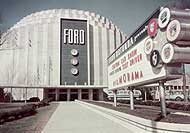
|
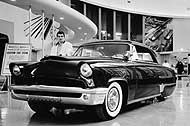
Nello Tacconelli owned this smoothed 3-year-old Mercury hardtop, which was part of the first Rotunda show.
|

Jack Elders’ ’51 Ford convertible had a chop along with other neat custom tricks, plus a 3/4-race flathead.
|

This ’53 Ford Victoria, owned by Frank Gilardone, had a questionable front end treatment, but the rear was pretty nifty.
|
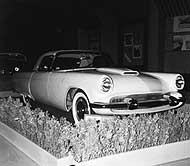
Barely a year old at the time, Bob Palmer’s ’55 Thunderbird received some tasteful customizing at the hands of Clark Kaiser.
|
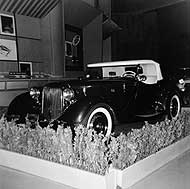
Before they became high-priced antiques, MG roadsters were tweaked by hot rodders. Under that hood and behind the chopped Deuce shell lives a hot Ford or Merc flattie, and ’55 and ’56 Ford hubcaps on steelies replaced the original wire wheels.
|
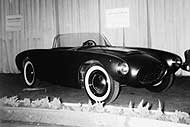
Here’s a homebuilt sport rod, and it is a little dandy. Wonder what reaction one of these would create today?
|

In this photo, you get a better view of Volpe’s heavily massaged ’48 Mercury, as well as a rear view of Gilardone’s ’53 Vicky.
|

Frank Mack dusted off his ’27 T roadster for the Rotunda show. The engine was a much-modified ’48 Mercury flathead, since small-block Chevys still weren’t too plentiful.
|
|



